Orlando City vs Inter Miami Tactical Analysis
- All Angles Football -
- Jul 13, 2020
- 6 min read
On Wednesday night, Inter Miami and Orlando City faced off in the first ever Florida rivalry between the two teams upon Major League Soccer’s return to play. Both of the Eastern Conference sides were searching for their first win this season. The game finished 2-1 to Orlando City with Nani scoring the winner in stoppage time. For most of the first half Orlando City was in control while Inter Miami came out as the better team in the second half up until Andrés Reyes’ injury which had a large impact on how the game turned out. This post will break down some of the tactics from the game.
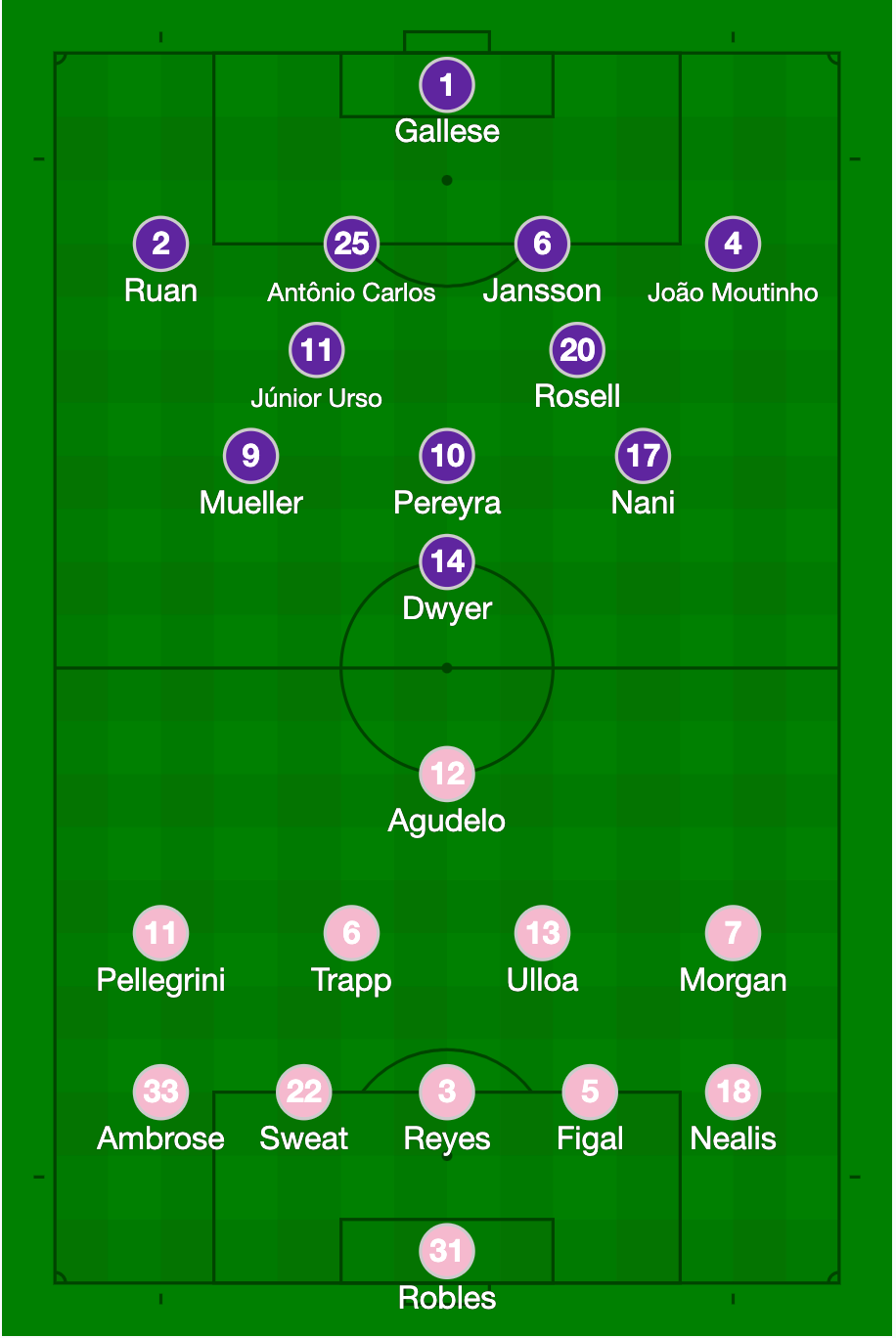
Inter Miami’s Defensive Set Up
For the first few minutes of the game, Inter Miami started off with often pressing Orlando high with much intensity through its central midfielders (Trapp and Ulloa), wingers (Pellegrini and Morgan) and sometimes the wing backs (Ambrose and Nealis). A few clips below display this intense high press for the early stages of the game (roughly the first 10-15 minutes). This high press saw Miami often push Orlando back and keep them in their own half. However, sometimes Orlando’s numerical superiority in central midfield saw them easily play the ball through Miami’s press. That would also be a possible explanation as to why most of the times Miami’s early high press worked were when they overloaded numbers on the wings when Orlando played the ball out wide.
Miami eventually calmed the intensity of their press and sat in a 5-3-2 defensive shape (with Pellegrini moving central to help combat Orlando’s numerical superiority in the middle) a few yards outside their box. Miami only pressed and attempted to win the ball when there was a reasonable opportunity to do so such as on bad touches or bad passes by Orlando’s attacking players. This made it more difficult for Orlando to play through Miami as Pellegrini had dropped central to a no. 10 role as mentioned in addition to Miami not leaving as much space in behind and in the middle as in the beginning with the high press. This defensive tactic which Miami continued with for most of the game matched back to what Taylor Twellman (ESPN commentator) said that Inter Miami coach Diego Alonso had said prior to the build up of the game which was “to dictate tempo without the ball, keeping shape and knowing when and where to press”.

Inter Miami in their 5-3-2
This strategy allowed Inter Miami to match up with Orlando City. They were even the better team for some portions of the game, especially at the beginning of the second half up until Andrés Reyes’ injury. One of the issues with this set up for Miami though had been that compared to their last game against D.C. United (in which they were arguably the better team, when Alonso first played a 3-4-3) Inter Miami’s defensive set up when they sat back was not as compact between the lines (specifically horizontally) which at times played into Orlando City’s hands given that they had a majority of possession at 58.1%. Another issue that hurt Miami with this setup was that as Pellegrini moved into a no. 10 role and Morgan shifted a bit more central (especially in the defensive phase), Inter Miami had lost their greatest asset from the beginning of the game which was their wingers (Morgan and Pellegrini) bombing down the wings and crossing balls into the box which twice created opportunities for Miami and another time resulted in a foul and this can be seen below.
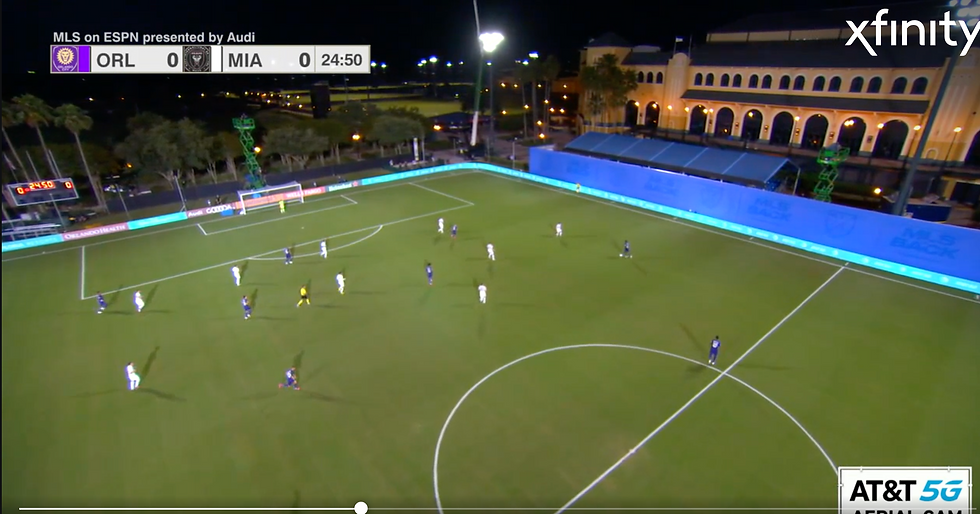
Inter Miami's lack lack of compactness horizontally. As can be seen there is enough space between Miami's players for Orlando's players to pick up and cause threats.

Although D.C. United players took up spots horizontally between Inter Miami players, Miami were a bit more compact horizontally which made it less dangerous.
Inter Miami created very dangerous opportunities down the wings through Morgan and Pellegrini.
Orlando’s Midfield Domination
As mentioned, Orlando City dominated possession and had superior numbers in central midfield for most of the game and Miami struggled with this throughout the game but especially in the beginning before Pellegrini moved centrally to help deal with this issue. As Orlando lined up with a 4-2-3-1 vs Inter Miami’s 3-4-3, this formation naturally brought this advantage to Orlando and the switch to a 3-5-2 as mentioned helped to counter this. Oftentimes, Orlando’s wingers (especially Chris Muller) would drift in centrally and this did not help the situation for Miami. The screenshot below displays Orlando having superior numbers in central midfield often giving them a man free allowing them to play the ball through and around Miami and create more opportunities.
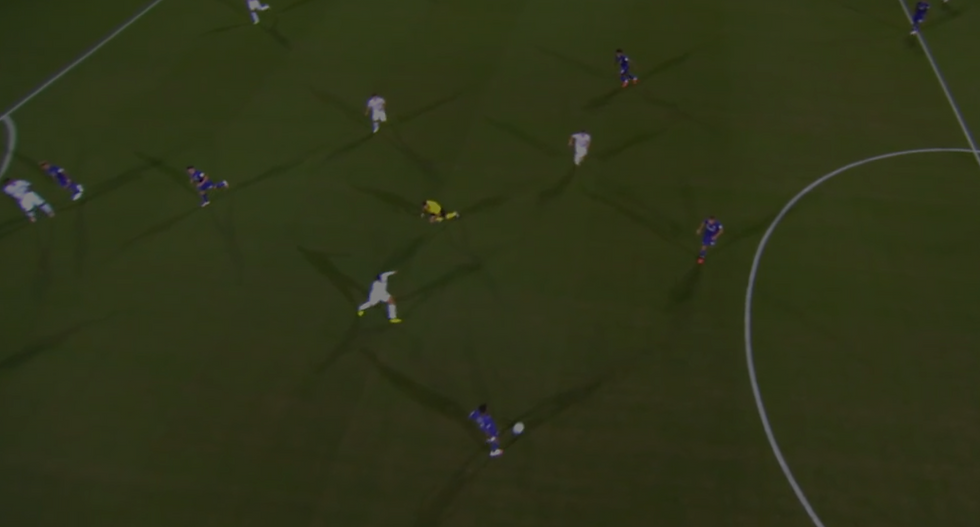
Injury Changes the Game
As mentioned, a major turning point in the game was Andrés Reyes’ injury. Inter Miami had come out in the second half as the better team, scoring the game’s first goal, walking over Orlando with possession being 60%-40% for the first 5 minutes of the second half which was essentially up until the injury occurred. Whether Miami were going to continue to dominate possession or concede possession like in the first half, if the injury didn’t occur is unknown, especially considering the expansion team’s identity isn’t fully constructed yet. This injury similarly affected Inter Miami though as did Roman Torres’ red card against D.C. United.
Pizarro, Inter Miami’s second DP, replaced Reyes after the injury and although the injury impacted Miami negatively, Pizarro showed what Miami were missing in midfield which was a ball carrier as a creative outlet. With Trapp and Ulloa in the middle, Miami lacked a player like Nguyen or Pizarro in the first half to carry the ball forward, create opportunities centrally and link Agudelo with the midfield. This was pretty clear from the following points:
Pizarro attempted the most dribbles (6) of any Miami players with only roughly 40 minutes on the field. Pellegrini was 2nd with 3
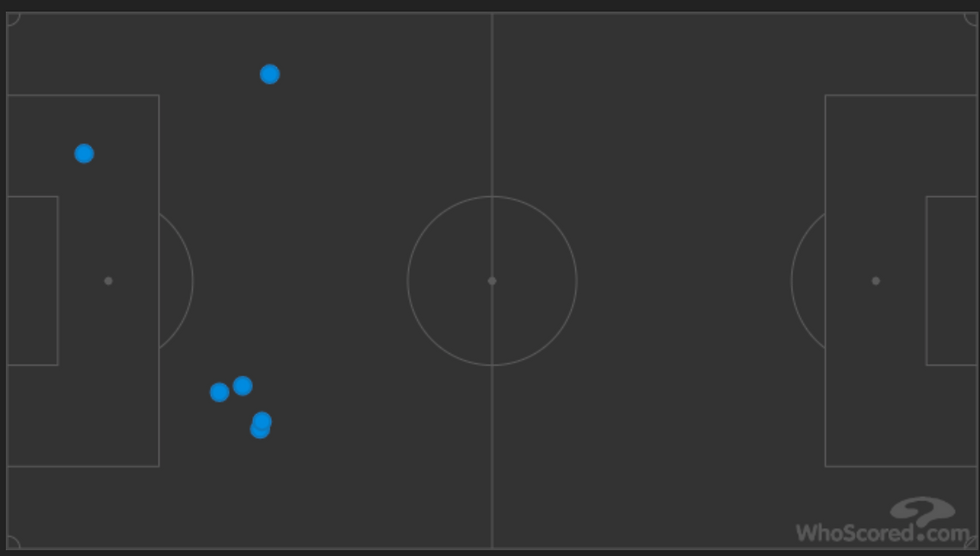
Nguyen created 2 chances after coming on to the field
Pizarro and Nguyen in their minutes combined (roughly 100), had 55 touches of the ball, with most being near/in the final third as seen below. Trap and Ulloa with roughly 180 minutes had 77 touches of the ball with not many being in/near the final third.
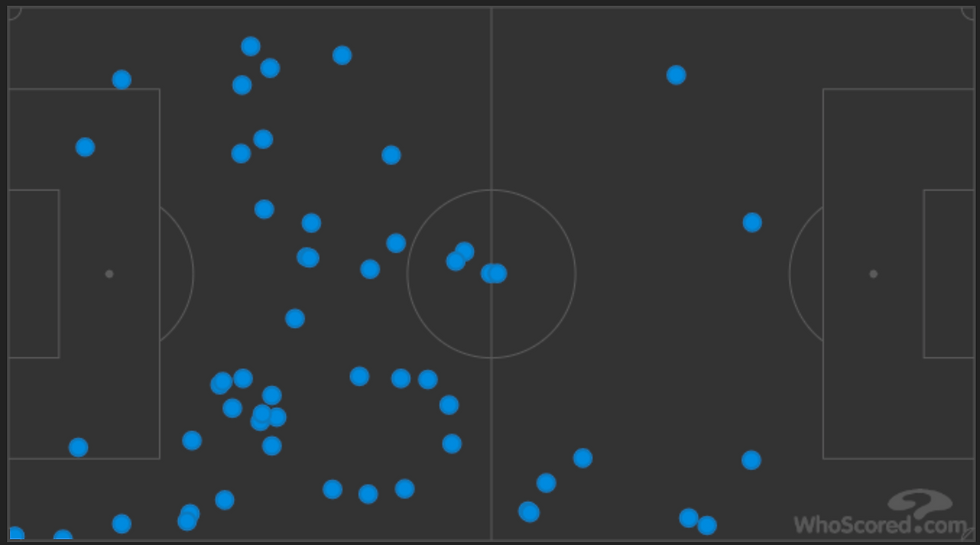
Above: Pizarro's and Nguyen's touches
Below: Trapp's and Ulloa's touches
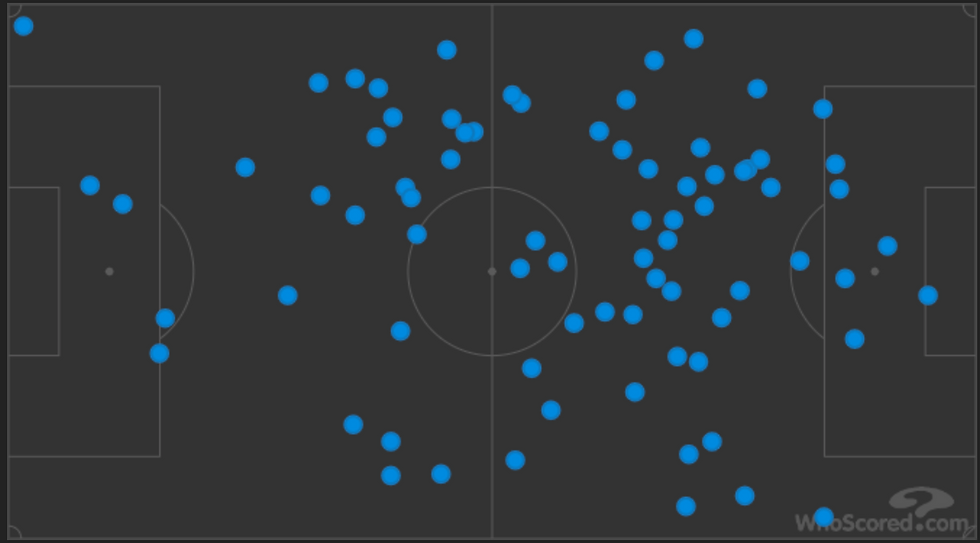
The clip below shows Miami winning the ball and the lack of an outlet to carry the ball forward in midfield to create any chances.
Although these changes showed what Miami missed going forward in the first half, the injury clearly affected Miami from being on the front foot for the beginning of the second half. This injury could have and likely had a mental impact considering:
The lack of match sharpness due to the long break
The disruption a 7 minute stoppage would have on the flow of the game
The impact the red card had on Inter Miami mentally in the game against D.C. United, which could suggest some mental fragility
The impact was also clearly tactical as Andrés Reyes was a stronghold in Inter Miami’s defense prior to the injury and although Pizarro had a positive impact going forward. Miami missed Reyes in the back line especially considering that to keep the defensive shape with 5 at the back, Ulloa slotted into a CB role which meant that 2 of Inter Miami’s 3 CBs were not natural CBs (Ben Sweat, natural LB, being the second). This tactically didn’t help Miami as they lost arguably their best player and therefore stability in their defense. Had the injury not occurred, it is reasonable to think that Inter Miami would have likely at least held Orlando to a draw, if not won the game.

Ulloa as a 3rd center back for Miami
Inter Miami continues to show positive signs on the pitch while the results desire to tell a different story. Diego Alonso and company will hope to get their first win Tuesday against the Philadelphia Union. It will be interesting to see how the club approaches Tuesday’s match as another step towards constructing its identity whether Alonso will opt for a 3-4-3 again or go back to the 4-2-3-1 from the opening match against LAFC and whether he will instruct Miami to press and dominate possession or concede possession and dictate tempo without the ball. On the other side of the match up, Orlando City got their first win for the season under new coach Oscar Pareja and will next face NYCFC on Tuesday night searching for their second win looking to make progress under Pareja to make the playoffs for the first time in club history.


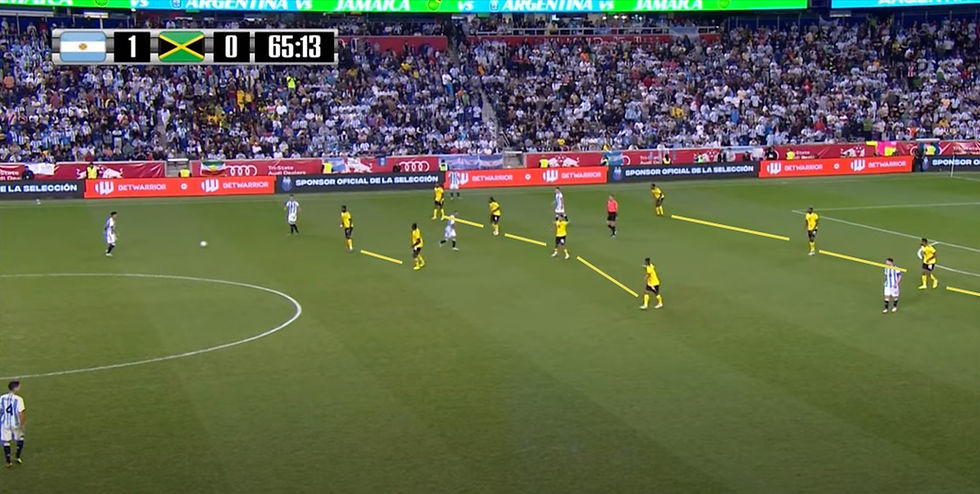
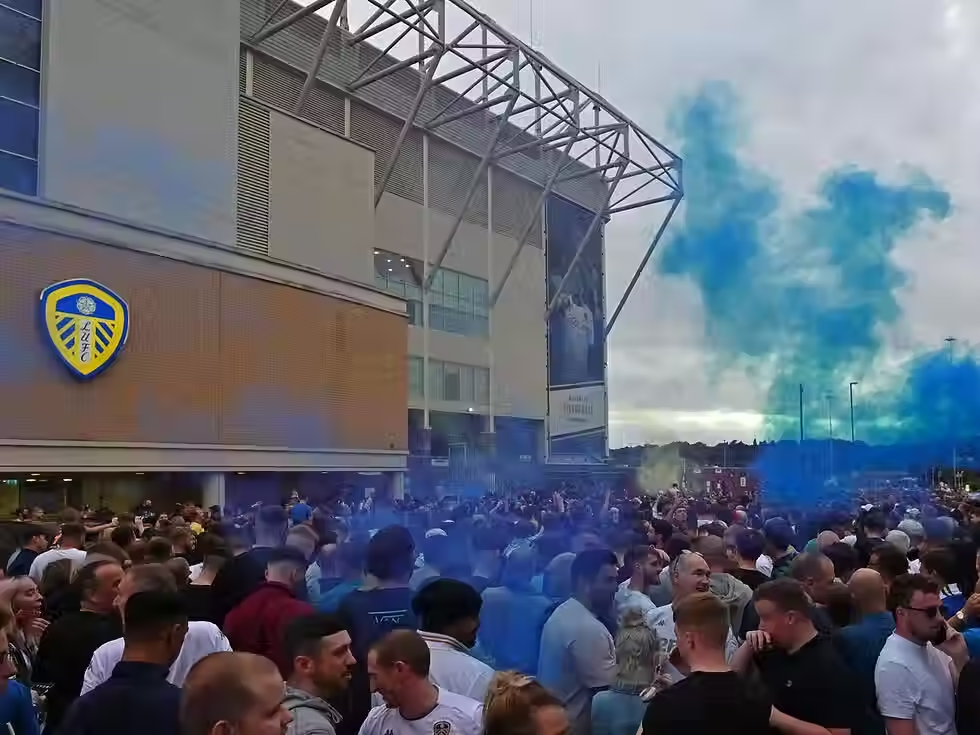
Comments